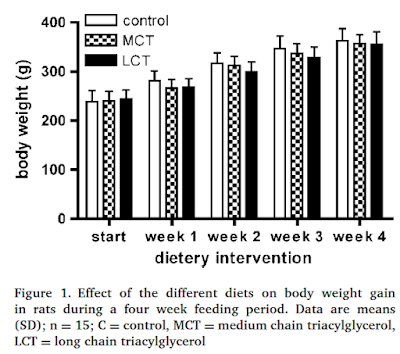I mentioned this paper in the last post:
Soybean Oil Is More Obesogenic and Diabetogenic than Coconut Oil and Fructose in Mouse: Potential Role for the Liver
First a reiteration of 5001 vivarium chow:

Then 25% fructose on the high coconut background:
Essentially the MCT diet is the Surwit diet without the sucrose. Not exactly obesogenic. It strikes me that the sucrose is essential to develop pathology on high fat diets. If you want to call obesity pathology, see below.
 |
and on the 10% soybean oil background
 |
So I think we can say that eating 25% of your calories as fructose might be excellent if you are a Bl/6 mouse who wants a fatty liver.
But what does fructose do to your weight/fatness?
That depends. If you are on coconut oil (+2% calories as linoleic acid) it increases your weight towards the weight of the soybean oil group.
If you are on soybean oil then including this much fructose decreases your weight to that of the coconut plus fructose group.
How come?
Sadly feeding mice on 25% of their calories as fructose generates rectal prolapses in 30-40% of those mice. And rectal prolapse is, in all probability, just a surrogate for chronic gut rot.
I would be very, very cautious about interpreting any of the data from mice with this degree of gut dysfunction. Which does nothing to allow me to decide whether the sucrose present in high "fat" diets such as the Surwit coconut/sucrose diet or any of several butter oil/sucrose diets is significant.
Which would be nice to know.
So let's look at a paper by Surwit's group:
Reversal of Diet-Induced Obesity and Diabetes in C57BL/6J Mice
All you have to do to reverse both obesity and diabetes in Bl/6 mice is remove the fat from the diet.
So let's look at a paper by Surwit's group:
Reversal of Diet-Induced Obesity and Diabetes in C57BL/6J Mice
All you have to do to reverse both obesity and diabetes in Bl/6 mice is remove the fat from the diet.
Here are the compositions. The low fat diet always reversed the problems from high fat in a few months. For Bl/6 and A/J (less obesity prone) mice:
If you glance down through the ingredients things look very similar except for the fat and carbohydrate composition. Right down to the inclusion of exactly 18.3g/kg of soybean oil to avoid essential fatty acid deficiency in each diet.
Aside: Of course most of the components are the same by weight. But not by calories. The high fat diet dilutes everything with saturated fat calories, by about 25%. This includes the linoleic acid from the 18.3g/kg of soybean oil. This is a very low (~roughly 1.6% kcal) LA diet. End aside.
Oh, and the sucrose. When the weights per kilogram of most components of the diets are identical to a decimal place, suddenly 10% of calories as sucrose arrives in the high fat diet. Why? Surwit discusses its inclusion and correctly points out that 10% sucrose in low fat diets does not cause obesity or diabetes in Bl/6 mice. But he does not address why the sucrose was "needed" in the high fat diet.
I leave you to speculate as to whether the sucrose is essential to the obesity model.
Okay, okay. I won't.
We just need this paper
The high fat diets contain about 40% of calories as MCT or long chain fats, both have around 1.6% of calories as linoleic acid. Oh, and were fed to rats, not Bl/6 mice. Here are the weight gains over the first month
Essentially the MCT diet is the Surwit diet without the sucrose. Not exactly obesogenic. It strikes me that the sucrose is essential to develop pathology on high fat diets. If you want to call obesity pathology, see below.
The mechanism can be best summed up as "fructose is very complicated", ie I dunno.
Of course, as we do know, the obesogenic and diabetogenic Surwit diet is the one Jim Johnson's lab used for longevity/insulin gene studies. I blogged about it here.
They found reduced insulin exposure promoted peak longevity on standard mouse chow. However maximal median lifespan extension came from the Surwit diet despite the mice with "normal" insulin gene dose becoming obese and hyperinsulinaemic on said diet.
My take home message is that becoming fat and diabetic on a low linoleic acid (+ 5% fructose) diet is possible and may be aesthetically problematic but it doesn't carry the vast array of mid to late life illnesses associated with becoming obese using linoleic acid. Peak longevity may be a different matter.
The relevance of sucrose inclusion for obesity generation remains fascinating. I think it's real.
Peter









